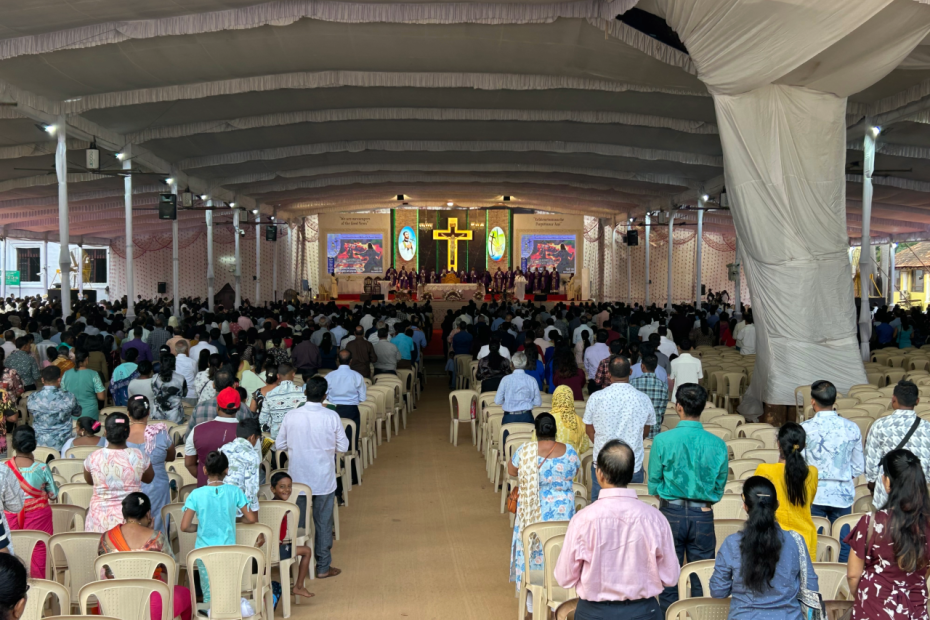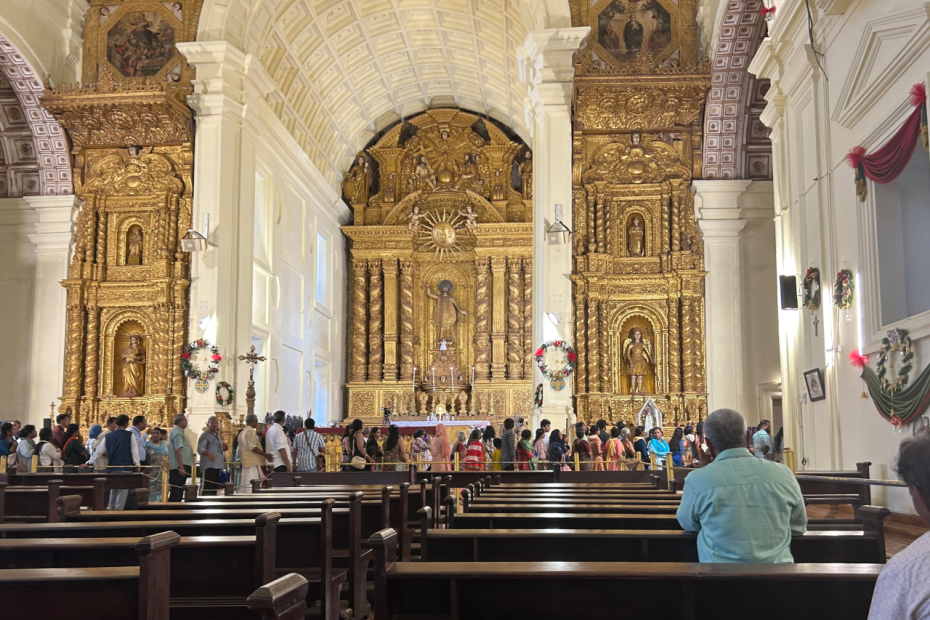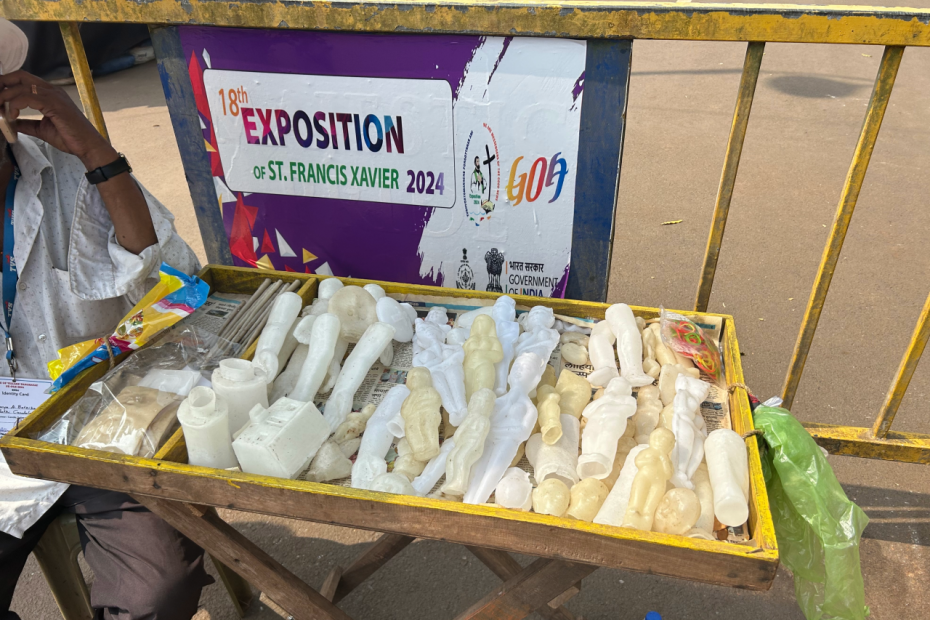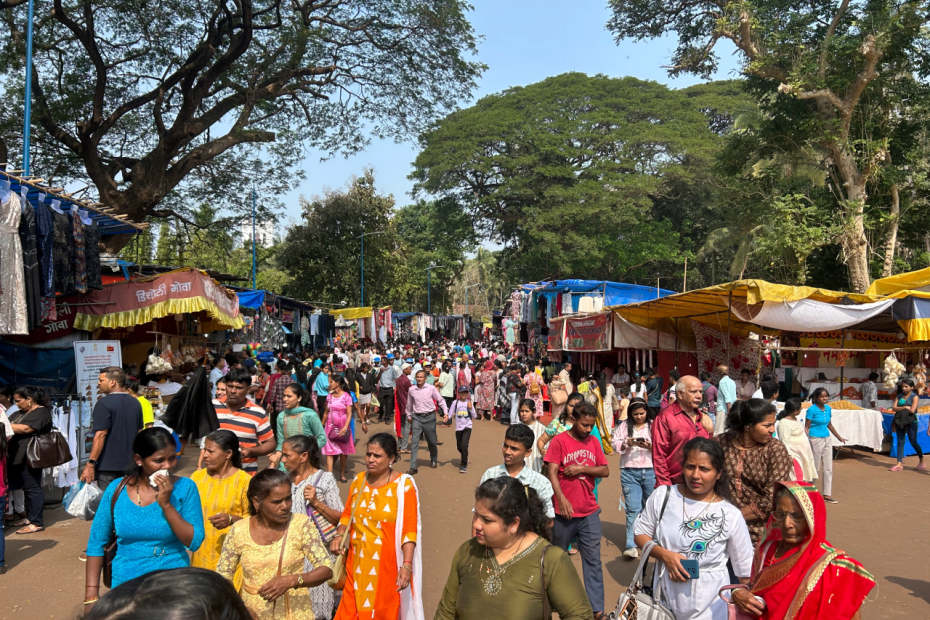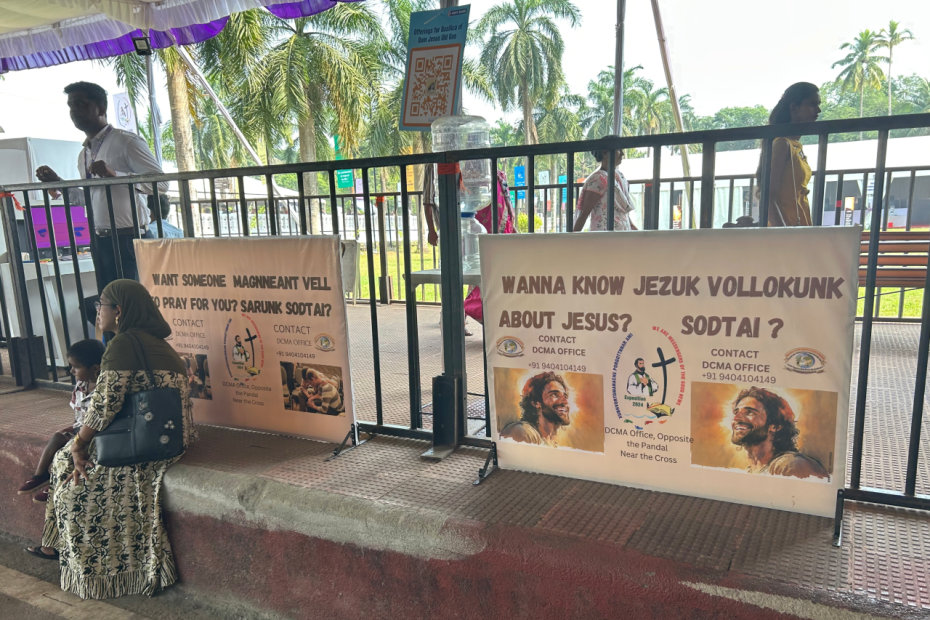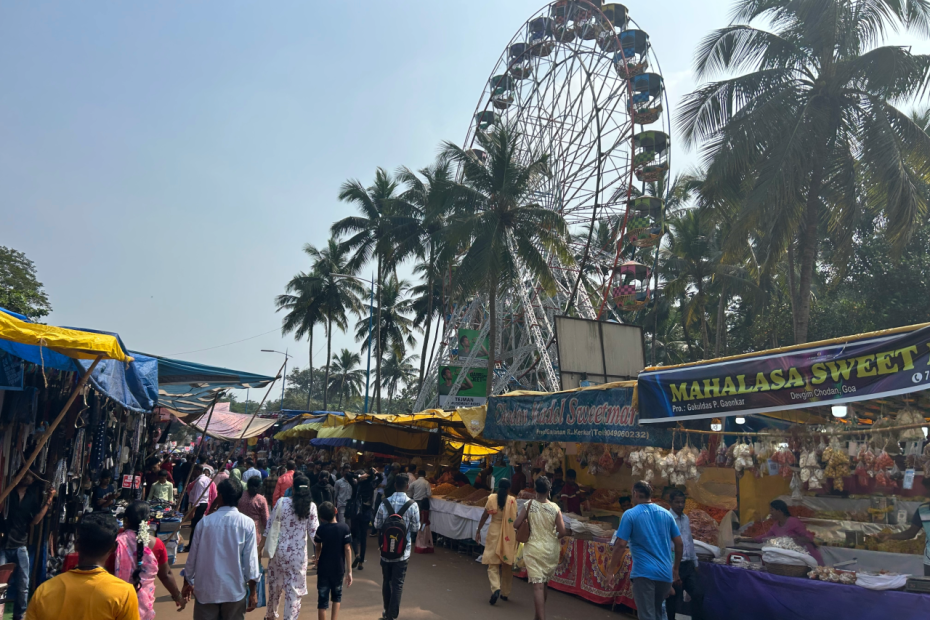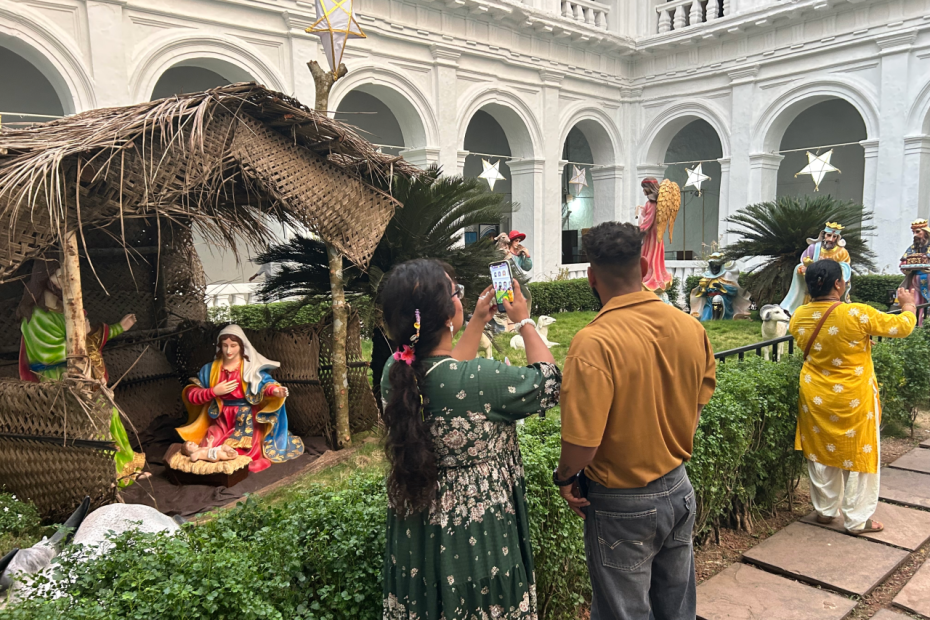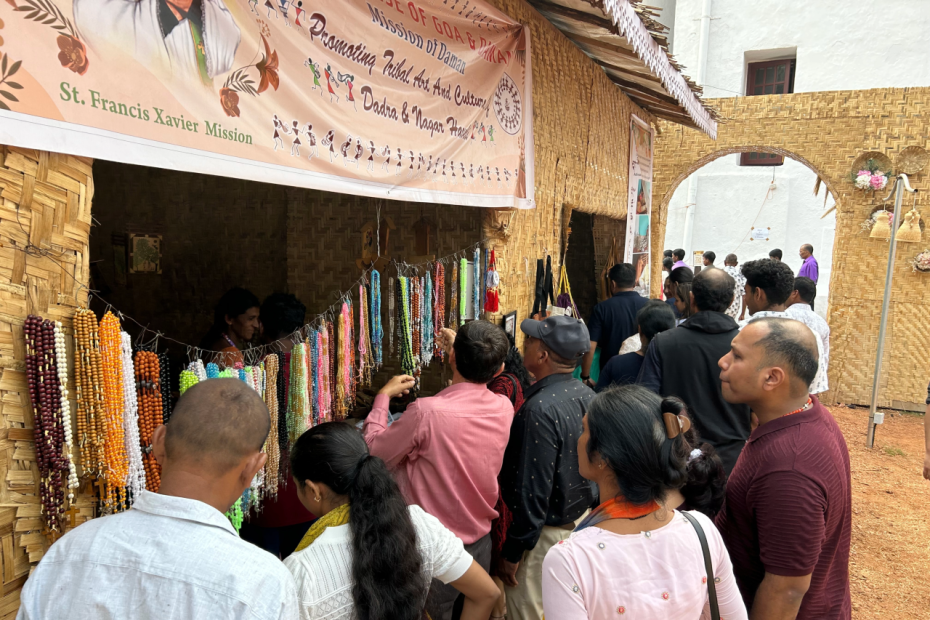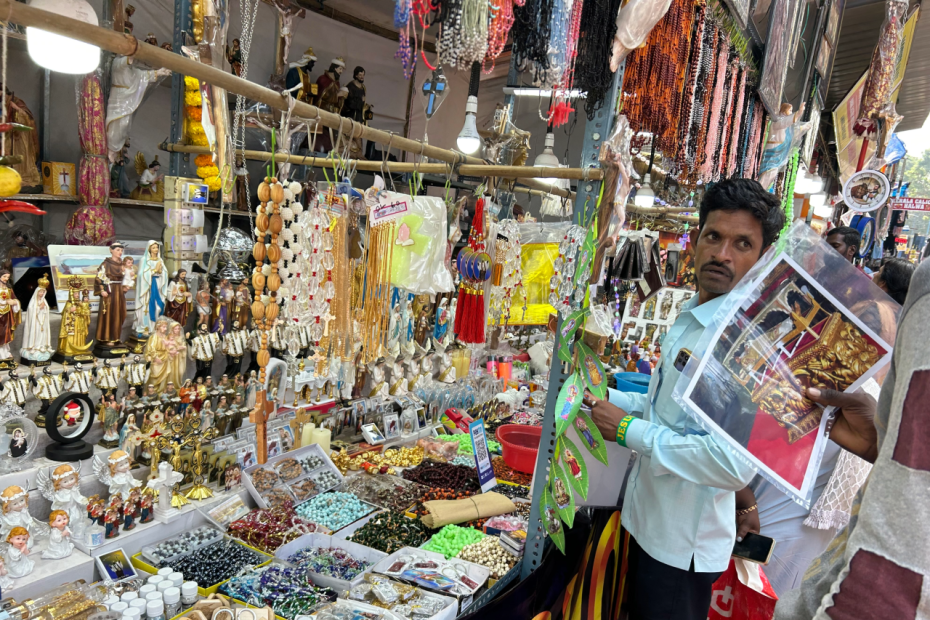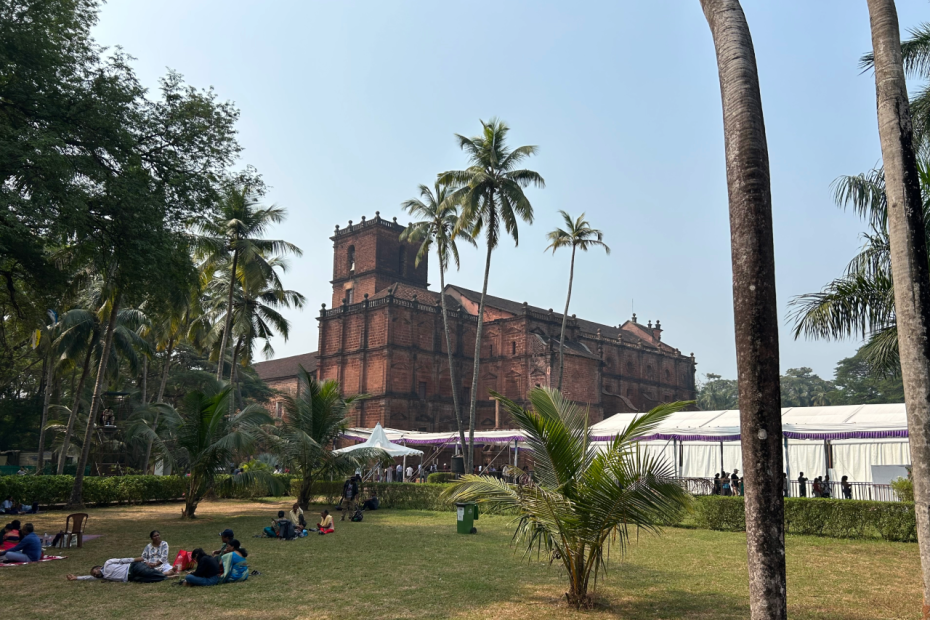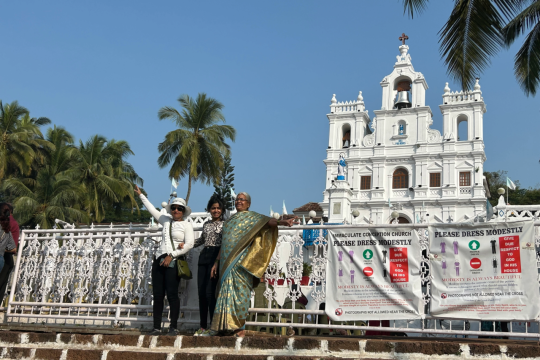In front of the celebrated Bom Jesus basilica, a UNESCO world heritage site in old Goa, India, the base of a large stone cross bears an inscription celebrating St. Francis Xavier as “Apostle of the Indies.” Inside the church, to the side of the altar, an elaborate reliquary houses most of the bodily remains of the saint, which pilgrims visit throughout the year. Though not the first missionary to Goa, Xavier is celebrated in most of the world for the reason written indicated in that title on the base of the cross—his energetic missionary work from India to Japan, which led the church to make him the patron saint of the missions.
Here in Goa, though, as local interviewees describe it, Xavier is especially celebrated for very different reasons—as “protector of Goa.” The centuries-long presence of his well-preserved body in Goa and the miracle-working power that they believe he still imparts often seem more important than his evangelization.1 Catholics readily recount instances when they believe that the miraculous intervention of Xavier provided special protection from disastrous storms and ill health. Though Westerners often see him as someone whose evangelism and conversions raised up Catholicism over other faiths—who belongs on one side of a religious divide—Xavier’s appeal in Goa is not limited to Catholics. A Muslim taxi driver reported, “he is the only religious figure who unites us. That is why we call him Goencho Saib, the Protector of Goa.” A Hindu man explained, “We call him the god of Goa because he protects us and gives us what we need when we ask for it.”2
A decennial outpouring
Every ten years, most recently in 2024/2025, Xavier’s body is brought down from atop a side altar in the Bom Jesus and processed about 500 meters to the nave of the huge and impressive Sé Cathedral, where pilgrims can visit it close up.3 During the 45-day exposition that follows, at least a million people–some media sources claim as many as 8 million–come to view his remains and often to touch his transparent casket.4 The area around the two large churches—once home to a large city but today largely open space—is transformed by the crowds who flock there.
Francis Xavier, born in Navarra, Spain in 1506, was one of the first companions who joined St. Ignatius Loyola to found the Jesuits. He was sent to Goa under the auspices of the King of Portugal, arriving in 1542.5 He traveled down and around the Indian coast to evangelize, moving on over the next decade to sites in present-day Malaysia, Indonesia, and Japan, and returning twice to Goa, the capital of Portugal’s imperial and religious empire in Asia. Xavier died in 1552 on Sancian island while waiting to find some way to enter China.
In 1554, Xavier’s body was brought to Goa, reputedly uncorrupt and sweet-smelling, though damaged during its original burial on Sancian.6 Accounts from that time say that his body was subject to incredible honor and popular devotion. Residents of Goa clamored for a chance to see the body, “push[ing] forward wanting to touch their beads and other things against the body of the blessed padre. In the end, they almost broke the rails in the church, and would not stop kissing his feet.”7 Though leading Jesuits pushed back against it, even as they tried to celebrate him, a popular cult arose that regarded Xavier as “a man who was… able to perform miracles at will—and even restore people to life.”8 Xavier’s body was placed in a closed casket, which was reopened in 1611 so that his arm, which iconically held a cross high while he was preaching, could be severed and sent to Rome. At that time, the body was reportedly still in an uncorrupted state.9
After his canonization in 1623, Xavier’s body was enshrined in a crystal coffin. Accounts from the mid-17th century describe crowds coming to visit his body around the time of his feast each year.10
The Exposition
The series of decennial exhibitions of St. Francis Xavier’s body—2024/25 is the 18th exhibition—dates to the mid-19th century. The exhibition described here, lasting 45 days from November 21, 2024, to January 5, 2025, is organized around Xavier’s feast day, December 3.
The exposition begins with the removal of the body from on high. The following day, it is solemnly processed along a path lined with invited members of the Goan Catholic community and other dignitaries.11 After a dedicatory Mass, the viewing is open to the public for 45 days, after which a procession escorts the body back to the Bom Jesus.
The line to see the body can stretch more than 400 meters, snaking through tents that help protect pilgrims from the sun. On weekdays, the waiting time can be relatively brief. On weekends, it is up to three hours, a wait that the organizers claim is an important part of the devotional experience. Most pilgrims seem to arrive by car or public transportation, but a doctor who cared for pilgrims on site said that some walked up to 10 days to be there. Many visitors dress in their best clothes, whether in the European styles common in Goa or, for women who had ventured further, elegant saris.
On the cathedral grounds, diocesan officials take pains to proscribe the form of devotion, emphasizing discipline, silence, and obedience. Decorum is strictly adhered to, and no photography is allowed. A half dozen volunteers monitor the movement of visitors as they silently process up the center aisle.
Xavier’s body, dressed in gold and red vestments inside the crystal and silver casket, is displayed in front of the altar rail. His body looks more like that of a mummy than a living person, but many bodily features are still recognizable. Pilgrims file past and often touch the glass near his feet and his head. Though leaders and volunteers talk about how emotional the experience of pilgrimage is, significant displays of emotion or even lingering are discouraged. Once devotees see and touch the casket, they are moved along, unable even to stay and pray before the other altars in the cathedral. On the mornings of this research, at the peak time for visitation, pilgrims passed through at a rate of 30-50 per minute.
On the grounds in front of the Bom Jesus, masses were celebrated hourly through the morning and late afternoon under large tents. Most were in Konkani, the native language of Goa. Additionally, there were liturgies for charismatic Catholics, speakers of other Indian languages, and English speakers. All of the liturgies observed were in the Roman rite, rather than the Syro-Malabar or Syro-Malankara rite.
One interviewee claimed that “90% of Catholics in Goa” come to the exposition. A civil engineer who volunteers at the exposition reported, “Most of the people who come here are Goan. But… I have noticed a lot of people from Kerala and Tamil Nadu [and] quite a number of Maharashtrians have come. These are the three main spots… Others have come from Andhra Pradesh, Delhi, Jharkhand, Arunachal Pradesh, Pondicherry, and even devotees from Andaman and Nicobar.”
What Xavier Meant to the Pilgrims
Conversations with pilgrims yielded a range of responses about why they had come to visit St. Francis Xavier. Leaders of a group from Jammu and Kashmir, a state in the far north of India with only about 7,000 Catholics out of a population of more than 12 million people, indicated that they had embarked on a 48-hour train ride in part for the opportunity to connect to a much larger group of Catholics. One group from Mumbai was even on a multi-day company outing built around the pilgrimage. The heads of the small business were Muslim, and the seven employees included Hindus and two Catholics. They chose this site for their outing because they had heard about St. Francis Xavier and wanted to experience what it was that drew others here.
Most pilgrims had come on family outings that combined religious devotion with meals and shopping at giant booths just beyond the church grounds. The booths were crowded with girls’ dresses, sneakers, pickles, ice cream, pocketbooks, purses, men’s floral print shirts, hot tea, plastic toys, artificial flowers, and more for sale. There was even a ferris wheel and other rides for entertainment. Some pilgrims admitted that the commercial aspect was part of the draw for families, but as one told me, “I tell my children what my parents told me: St. Francis Xavier comes first. After that, you can get a toy.” That seemed to be borne out in the church grounds, where no one seemed to be carrying packages from the shops. On observing the same arrangement at a prior exposition, anthropologist Pamila Gupta argued that the arrangement “allows Xavier’s corpse to operate at two different registers, that of officialdom (and solemnity) inside the Sé Cathedral and playfulness on the outside.”12 Except for one tour group from Carnival cruises, the exposition seemed to be an entirely Indian event.13
The particulars of St. Francis Xavier’s life—his origins, travels, and evangelization—were often only sketchy to pilgrims. Some reported that he was Portuguese. A few said it was important that he brought faith in Jesus to many people in India and elsewhere, but just as many people pointed out that through the Thomas Christians, the faith had already been brought to India long before. Rather, stories about Francis Xavier’s power and sanctity while alive, and about the ongoing power and sanctity of his body, which protects from sickness and natural calamity, and the fact that it rested here in Goa rather than anywhere else, were the primary reasons pilgrims offered for being there.
For the clergy, a pilgrimage volunteer suggested, Xavier is a role model whose evangelical work is the impetus for their devotion. “I would say role model is more for the clergy, where they will look at him and say, If I had one percent of St. Francis Xavier[’s energy], what would I be? But to lay people less so.”
She ascribed Xavier’s importance to Goan laypeople like her, quite differently, highlighting a continuity of miraculous power stretching from his lifetime to the present day: “They say when he used to pray around here, in the area, he would pray with so much fervor that he would levitate… He has raised people from the dead. He has healed. He has done so many miracles as a living person.” She continued, “There have been many Jesuit missionaries, many who brought the faith to India… There were lay catechists who he taught, who would have spoken Konkani or Malayalam or Tamil [which Xavier did not speak], and [therefore] have done a lot of the [missionary] work. But he's the one who stands out to Indians… because of the relic that we have here, [the body] of Saint Francis Xavier.”
Of all the saints, one man said, “he is the most miraculous saint we have. We believe so.” He touted Xavier’s power to protect and to heal, even claiming that he had “resurrected many children.” To this man, as to many others, Xavier’s bodily incorruption proved his saintliness.
Another woman reported, “We have St. Francis Xavier with us… We believe that Goa is protected because of his being in Goa. His relics being in Goa has protected Goa from all adversities. From the worst cyclones which come to Goa, somehow they get deflected. Somehow they don't damage Goa… we want St. Francis Xavier here because we know our land will be safe.” A man offered another example: “the tsunami waves hit up to Kerala and up to Karnataka. Goa was spared.” Another man spoke of instances of Goa being spared from floods “because of his presence here.”
The title Goencho Saib, the protector of Goa, apparently derives from the belief that he protected Goa from invasion during the Maratha-Portuguese War (1683–1684). The scope of his protective power has expanded since then to include protection of the whole of Goa or individuals and their families, “for anyone who comes to his feet, irrespective of their religion,” a devotee reported.
A Complicated Understanding of Miracles
If a classic understanding of a miracle, at least in many parts of the world, is that there is a divine intervention that results in everything turning out well, many of the “miraculous” intercessions ascribed to Xavier’s presence were often more complicated.
Some of the miracles recounted were straightforward–a mother who had recovered from terrible burns and able to live a normal life, a hunchback cured, stroke victims recovered. A doctor recalled that during the COVID-19 epidemic, he had to keep his clinic staff working and told them, “We are in the holy land of St. Francis Xavier. You will not get COVID. And none of them did… From September until the vaccine came on 16th of January, none of them got COVID. But all of the other hospitals, other than Old Goa, all the teams got infected. The doctors, the nurses. So, I consider for me it's a miracle. 65 people working in the red zone, in the ICU, fighting the virus. They did not get COVID. They used to go back home, nor their relatives got COVID… my wife did not get COVID. I used to go every day home in the night and come back in the morning. So, I consider it a miracle.”
In the climate examples cited above, bad things happened to other people–cyclones “deflected” and tsunamis that hit elsewhere, but not Goa. In the history of miracle stories, stories about events that one person was spared from, even if others were killed, are not entirely unusual, but some accounts were more complicated. What believers meant by “miracle” did not always entail recovery.
The doctor reported helping a pilgrim who collapsed having just been to Mass and confession at the exposition. He intervened and she lived for several days, dying on the feast of St. Francis Xavier after her family was able to see her and could get “completion.” “They were happy that she passed away on a feast day.” “So, that was one miracle, sort of, for me. Because some people might say, oh, she still died… it was a miracle to understand that [her] children, I'm giving time to celebrate [their] mother's death, come to terms that she will not be there. You know, that is sort of a miracle.” She “died in the holy land… on a feast day… That helps you complete with yourself. And it helps you to grieve over it. And then you live your life normally…You should not grieve over me and not spoil your life…So, that is a miracle…God gave time.”
Another woman spoke about ways that her nephew, who had cancer, was helped by Xavier, yet the story still ended with his death as a teenager. The miracles that she saw in it were manifest in smaller details and in the ways her family made the best of tragedy.
One complication to a miracle story touches the heart of the feast. The relatively uncorrupted state of Xavier’s body is, as people described it, an essential draw, a proof of his sanctity. But many also said that the body is now decaying and that 2024 may indeed be the last time it can be put on display. Pamila Gupta was told the same by some of her interviewees in 2004.14 She refers to it as a “sense of imminent foreclosure,” of “history-in-the-making” that pilgrims should be there to mark and remember in case it does not happen again.15 In essence, though, it means that a central miracle that justifies the feast is both being undone, and is a cause for attending at the same time.
Seeing and Feeling
A number of pilgrims talked about having come here to see the body of Xavier, something that is difficult to do in the Bom Jesus basilica, but many others talked about being able to touch the casket, or about powerful feelings that emanate around the body, and about the ability “to be near the sacred relic.” One person described it this way: “The faith is if I go and touch my feet on the holy land here and touch his relics, my life will be... I've been three, four times.” “Touch is important,” he continued. “Being in that atmosphere. Going there. Probably, we get that spirit. You know, we get that energy. We get that... How do you describe it? I don't know what you'll describe it. And one's self feels better. Now, I myself am feeling so much better being in this place. Probably, I take that energy with me, go back home and then life is altogether different. It's touch. You'll see a lot of people if you go, they touch it. They have something with them. Probably a scapular or a cross or a rosary. They touch the rosary there, and they take. So, probably that energy is going to... The spirit is going to remain in the rosary, and I'm going with that home and then…”
Particular traditions
Attendees reported two other local traditions that related to St. Francis Xavier. One woman shared that there was even a tradition in her family that Francis Xavier was her godfather, though her uncle had been the person who stood in for him at the baptism. The uncle was recorded as the godfather, but in reality, she and her family considered Francis Xavier to be the real godfather.
Another tradition is known in Konkan as aangon, whereby a devotee comes to ask for some favor, such as a baby, and when the baby is born, returns to the saint and places before him a small wax statue of a baby. Small wax figures signifying some body part could be found for sale from the same vendors. Gupta claimed that in 2004, “In the central square, one is besieged on all sides by men selling wax arms, feet, hearts, and other body parts, the Catholic belief being that one tries to cure a particular ailment by burning a wax replica of that same body part in honor of Xavier, who will then intercede on one’s behalf, a ritual practice once again reminiscent of colonial times.”16 In 2024 there were few sellers of such goods, most of whom had only a box or a tray to offer.
A Social Unifier
If it is true that “90% of Catholics in Goa” come to the exposition, Catholics were proud that so many other Goans participated. They seemed to see nothing unusual in it. Banners along the central road between the churches quoted religious leaders from several faiths, even as volunteers stood by signs that offered more information for those who might want to learn more about Jesus.
The Muslim man mentioned earlier ascribed local Muslim and Hindu attraction to Xavier this way: “For miracles, protection, they pray and their work is done [their needs are granted].” He acknowledged that some Indians try to undermine that unity by pointing out Xavier’s role in encouraging the Inquisition in Goa, but that was only to divide people, he thought. People he knew could relate to Xavier and believed that he cared for them. “Something they have in their heart for Francis Xavier.”
Chandra Mallampalli, a historian of South Asia, recounted in a lecture, “popular devotional Catholicism… adopts many of the categories and motifs of popular devotional Hinduism and popular devotional Sufism. I’m not saying the content is the same but I’m saying the form is the same because the most important personality in Hindu society is the wandering world renouncer who renounces the world, renounces material possessions, denies the body, commits himself to a life of celibacy, and through this life of self denial and self-effacing, even willingness to become a martyr, that person acquires some sort of divine power–power to heal, power to cast spirits out of people. And people assigned all of these attributes to Francis Xavier and to Francis Xavier‘s body and any kind of shrine to Francis Xavier, that going there can cure problems of infertility. Going there can cure illnesses. This is something that is very much a part of popular devotional Catholicism, [and] this is just an adaptation that happens in India and you see a parallel in the history of Muslims in South India.”17
The foreigner who belongs here
In post-colonial Goa, indeed in the last region of India to be “liberated,” one of the most interesting things about devotion to St. Francis Xavier may be the fact that he is a European, yet somehow “our” saint, as he was often described. Even more, though he was not a native Portuguese, in the stories that pilgrims recount about him, he was made to be Portuguese.
Two interviewees offered stories of his attachment to Goa. “They tried to take him back to his own country. But at that time, the ship was not moved. They tried repeatedly, but he would not be moved.” “In 1961, they [the Portuguese] tried to take him back after independence. But no, he wouldn't go.” After other colonial agents were made to leave, Francis Xavier is the colonial agent who is honored as “ours” because he refused to leave.
What’s most important, though, is the quite genuine belief among Goans who were interviewed, both Catholic and not, is that Francis Xavier is “our” saint, in a way that Mallampalli describes, and in a way different than he is a saint of the universal Church.
- 1Research for this project is centered on participation at the Exposition of St. Francis Xavier from December 6-10, 2024, including formal and informal interviews with dozens of pilgrims on the exposition grounds and with other Goans in Panaji and surrounding villages, all in the traditionally more Christian core area known as the “Old Conquests,” supplemented by published sources as noted. Interviewee quotes in the remainder of this article are drawn from those interviews.
- 2Those who know India well may not be surprised to find that many Hindus are open to engaging Christian saints, though there are powerful political forces working to set up clearer boundaries. Alexander Henn’s in-depth ethnography of Goan Catholic and Hindu practice suggests that there are many ways that Hindu-Catholic devotions overlap a great deal. Muslims and Catholics, as the prior two quotes suggest, likely have more tightly bounded religious lives. Alexander Henn, Hindu-Catholic Encounters in Goa: Religion, Colonialism, Modernity (Indiana University Press: 2014).
- 3The exposition honors a body who in fact is always present—if just out of reach above those who visit it—yet turns into a major occasion when brought a bit closer to us. This calls to mind parallels with the image of the Black Nazarene in the Philippines or many Marian and saintly devotions where the image is brought down from above the altar to be processed for a short while and then returned.
- 4See, for example, “Xavier Exposition Draws 7 Million” or “8.1 Million Devotees Attend St Francis Xavier Exposition Over 45 Days.” Goans reported that the largest crowds are there in the week up to St. Francis Xavier’s feast day (December 3). During visits for this research, the crowds were substantial, but the number of people per minute passing into or out of the cathedral was at most one-fifth of the number who would have had to pass through 12 hours a day for all 45 days to reach 8 million. Lissy Maruthanakuzhy, “Xavier Exposition draws 7 million,” Matters India, January 9, 2025; Herald Team, “8.1 Million Devotees Attend St Francis Xavier Exposition Over 45 Days,” O Heraldo, January 8, 2025.
- 5Under a system known as the Padroado, organized before the Vatican developed its own missionary system, Portugal was delegated rights and responsibility for missionary efforts in a broad swath of territory.
- 6William R. Pinch, “The Corpse and Cult of Francis Xavier, 1552–1623,” in Engaging South Asian Religions Boundaries, Appropriations, and Resistances, ed. Mathew N. Schmalz and Peter Gottschalk (SUNY Press, 2011), 114-116; Liam Matthew Brockey, “The Cruelest Honor: The Relics of Francis Xavier in Early-Modern Asia,” The Catholic Historical Review 101, no.1: 41-64.
- 7Melchior Nunes Barreto to Ignatius Loyola, “At Sea,” in Wicki, Documenta Indica 3:76–77, cited in Brockey, “The Cruelest Honor,” 49.
- 8Pinch, “The Corpse and Cult of Francis Xavier,” 122.
- 9Brockey, “The Cruelest Honor,” 54.
- 10Brockey, “The Cruelest Honor,” 58-59.
- 11Participation at the opening procession was more carefully controlled in 2024-25 than in the past, according to attendees.
- 12Pamila Gupta, “The Corporeal and the Carnivalesque: the 2004 Exposition of St. Francis Xavier and The Consumption of History in Postcolonial Goa”, Etnográca [Online], vol. 21, no.1 (2017): 112.
- 13Gupta seems to encounter many more foreign tourists and skeptics than I encountered in 2024. Gupta, “The Corporeal and the Carnivalesque,” 114.
- 14Gupta, “The Corporeal and the Carnivalesque,” 114, 120-21.
- 15Gupta, “The Corporeal and the Carnivalesque,” 120.
- 16Gupta, “The Corporeal and the Carnivalesque,” 120.
- 17Chandra Mallampalli, “Catholicism in India: Blending in and Staying Apart, 1500-Present,” McFarland Center, Worcester, MA, February 18, 2025, 53 min., 10 sec.
